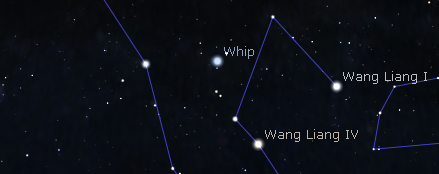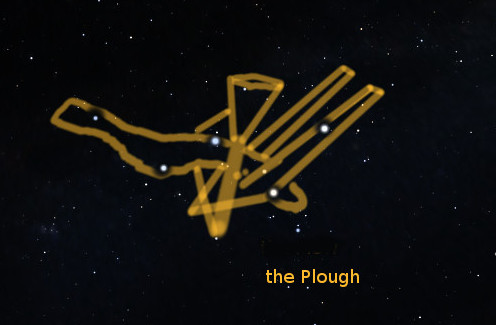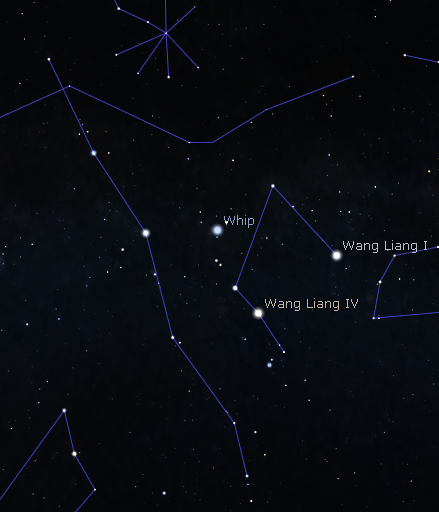Tür 5: Schwan und Kassiopeia

Wie auch beim Kepheus ist die Schreibform mit K vorne die ursprüngliche griechische Form, C ist Latein. Joh. Elert Bode im Jahre 1782 schrieb in seiner Sternkarte, die sich u.a. an ein breites, interessiertes Laienpublikum richtete, “Cassiopeja”, denn wenn man es auf Deutsch mit einem “j” statt “i” schreibt, spricht man es auch richtig aus: Buchstabenhistorisch ist dabei nämlich relevant zu betrachten, dass es den Buchstaben Jot im Lateinischen nicht gibt, sondern “i” manchmal unser “i” und manchmal eben auch “j” ist. Das kennen wir ja von unserem “y” (“Yacht” versus “sexy“), das auf Französisch übrigens “griechisches i” genannt wird, weil es im Altgriechischen die zwei i-Laute “iota” und “ypsilon” gibt. Cassiopeia schrieb man griechisch mit iota, während es im lateinischen alternativlos ein “i” wurde, bei dem der Leser nie weiß, ob er es “i” oder “j” aussprechen soll… Wir verwenden heute nunmal offiziell die lateinischen Bezeichnungen der Sternbilder, aber der Name der Königin stammt ja nun einmal aus der altgriechischen Mythologie und Sprache. Also hat Bode schon irgendwie recht, Cassiopeja zu transliterieren, nur konsequenterweise müsste man dann auch “k” statt “c” schreiben: griechische Kassjopeja wird zur lateinischen Cassiopeia.
Kassiopeia ist ein mythologische Königin, die für ihre Eitelkeit berühmt war und an den Himmel als schlechtes Beispiel gesetzt wurde. Ihre Tochter ist die schöne Andromeda, über der sie – recht klein – am Himmel thront. Auf dem Atlas Farnese ist sie mit gebietender Gestik dargestellt: Die obere Hand langt zu ihrem Gemahl, die weisende Hand zu ihrer Tochter. In diesem Bild ist nichts von Eitelkeit erkennbar: weder betrachtet sie sich im Spiegel (Metallspiegel übrigens, wenn überhaupt, denn Glasspiegel sind etwas hochmodernes), noch hält sie eine Feder oder sonstigen Schmuck. Die zackige Form wird auf das Himmels-W angepasst, da die sitzende Dame mit ihrem Armen gestikuliert:
Door 5: Cygnus and Queen Cassiopeia
As with Cepheus, the spelling with K in front is the original Greek form, C is Latin. Joh. Elert Bode in 1782 wrote “Cassiopeja” in his star map, which was aimed at a broad, interested lay public, because if you write it in German with a “j” instead of an “i”, you also pronounce it correctly: From a letter-historical point of view, it is relevant to consider that the letter jot does not exist in Latin, but that “i” is sometimes our “i” and sometimes also “j”. We know this from our “y” (“yacht” versus “sexy”), which, by the way, is called “Greek i” in French because ancient Greek has two i-sounds, “iota” and “ypsilon”. Cassiopeia was written in Greek with iota, while in Latin it became alternatively an “i”, where the reader never knows whether to pronounce it “i” or “j”… Today we officially use the Latin names of the constellations, but the name of the queen comes from ancient Greek mythology and language. So Bode is somehow right to transliterate Cassiopeia, but consequently one would have to write “k” instead of “c”: Greek Cassiopeia becomes Latin Cassiopeia.
Cassiopeia is a mythological queen who was famous for her vanity and was set in the sky as a bad example. Her daughter is the beautiful Andromeda, above whom she is enthroned – quite small – in the sky. On the Atlas Farnese she is depicted with commanding gestures: The upper hand reaches out to her husband, the pointing hand to her daughter. There is nothing of vanity in this picture: neither is she looking at herself in the mirror (metal mirrors, by the way, if at all, for glass mirrors are something highly modern), nor is she holding a feather or other jewellery. The jagged shape is adapted to the sky-W as the seated lady gestures with her arms:

Ornitos (Vogel) – heute Schwan
Der Schwan, der uns in Planetarien gern als Verwandlung des Zeus erklärt wird, ist in der griechischen Astronomie lediglich ein Vogel (ornitos). Er hat nicht wirklich etwas mit Zeus zu tun, sondern er fliegt einfach die Milchstraße entlang – außer natürlich in der Mythologie:
Ornitos (bird) – today swan
The swan, which is often explained to us in planetariums as the transformation of Zeus, is merely a bird (ornitos) in Greek astronomy. It doesn’t really have anything to do with Zeus, but simply flies along the Milky Way – except in mythology, of course:

Babylonisch war der griechische Vogel ein Dämon, genannt UKADUA, der als Mischform aus Raubkatze und Vogel dargestellt wurde. Der UKADUA war vermutlich ein Sturmdämon mit weit aufgerissenem Maul, der zusammen mit dem Blitze schleudernden Wettergott Adad oder mit dem Kriegsgott Ninurta auftrat. Der sumerische UKADUA wurde als eine Art Panthergreif abgebildet und später akkadisch auch mitunter das Wort für Panther (statt Ukadua) aufgeschrieben. Gemeint blieb vermutlich immer dasselbe – also nicht das Tier, die arabische Raubkatze, sondern der Dämon.
Cassiopeia war babylonisch das Sternbild “Pflug”, das wichtigste, auffälligste am Nordhimmel und eine bedeutende Orientierungshilfe. Der mittlere Stern (gamma Cas) hatte den Einzelnamen “der Säher”, weil es zu den größten technischen Innovationen im -2. Jt im Zweistromland gehörte, dass man einen Pflug mit einem Saattrichter entwickelt hatte, mit dem die Saat gleich in die vom Pflug gezogene Furche eingebracht werden konnte.
Babylonian, the Greek bird was a demon called UKADUA, which was depicted as a hybrid of a predatory cat and a bird. The UKADUA was probably a storm demon with its mouth wide open, appearing together with the lightning-throwing weather god Adad or with the war god Ninurta. The Sumerian UKADUA was depicted as a kind of panther’s grasp and later Akkadian also sometimes wrote down the word for panther (instead of ukadua). What was meant was presumably always the same – i.e. not the animal, the Arabian cat of prey, but the demon.
Cassiopeia was Babylonian for the constellation “Plough”, the most important, most conspicuous in the northern sky and an important orientation aid. The middle star (gamma Cas) had the single name “the seeder”, because it was one of the greatest technical innovations in the -2nd century in Mesopotamia that a plough with a seed hopper had been developed, with which the seed could be immediately placed in the furrow drawn by the plough.

China
Die fünf Sterne von unserem Himmels-W werden im Chinesischen zerpfückt in drei Sternbilder: Der westliche Teil heißt nach dem mythologischen General Wangliang, der Mittelstern (gamma Cas) ist seine Peitsche und der östliche Teil der Figur bildet mit anderen Sternen den “Fliegenden Corridor”, der zum Baldachin des Kaisers am Nordtor des Verbotenen Palastes und den Gasthäusern (für ausländische Diplomaten) führt.
China
The five stars of our celestial W are divided into three constellations in Chinese: The western part is called Wangliang after the mythological general, the middle star (gamma Cas) is his whip, and the eastern part of the figure forms the “Flying Corridor” with other stars, leading to the Emperor’s canopy at the north gate of the Forbidden Palace and the inns (for foreign diplomats).


